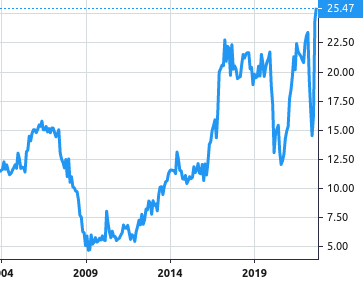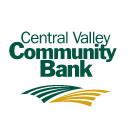About Central Valley Community Bancorp
Community West Bancshares operates as the bank holding company for the Central Valley Community Bank that offers a full range of commercial banking services to small and medium size businesses, and their owners, managers and employees in the central valley area of California.

Nine contiguous counties are served in California’s central valley, including Fresno County, El Dorado County, Madera County, Merced County, Placer County, Sacramento County, San Joaquin County, Stanislaus County, and Tulare County, and their surrounding areas.
The bank operates various full-service banking offices in Clovis, Exeter, Folsom, Fresno, Gold River, Kerman, Lodi, Madera, Merced, Modesto, Oakhurst, Prather, Roseville, Sacramento, Stockton, and Visalia. The bank conducts a commercial banking business, which includes accepting demand, savings and time deposits and making commercial, real estate and consumer loans. It also provides domestic and international wire transfer services and other customary banking services. The bank also offers Internet Banking that consists of inquiry, account status, bill paying, account transfers, and cash management. The bank does not offer trust services or international banking services and does not plan to do so in the near future.
The bank has a Real Estate Division, an Agribusiness Center, and an SBA Lending Division. The Real Estate Division processes or assists in processing the majority of the bank’s real estate related transactions, including interim construction loans for single family residences and commercial buildings. The company offers permanent single family residential loans through the company’s mortgage broker services.
The company’s loans are collateralized by real estate, listed securities, savings and time deposits, automobiles, inventory, accounts receivable, machinery and equipment. The company attracts deposits from individual and commercial customers.
At December 31, 2023 approximately 84.8% of the company’s loan portfolio held for investment consisted of loans secured by real estate, including construction loans, equity loans and lines of credit, and commercial loans secured by real estate, additionally 10.7% consisted of commercial loans.

The company’s business activities are primarily concentrated in Fresno, Madera, Merced, Placer, Sacramento, San Joaquin, Stanislaus, and Tulare Counties in California.
Loans
As of December 31, 2023, the company’s loan portfolio included commercial loans, such as commercial and industrial loans and agricultural production loans; real estate loans, such as construction & other land loans, commercial real estate - owner occupied loans, commercial real estate - non-owner occupied loans, farmland loans, multi-family residential loans, 1-4 family - close-ended loans, and 1-4 family – revolving loans; and consumer loans.
Investment Portfolio
As of December 31, 2023, the company’s investment portfolio included debt securities, including U.S. treasury securities; U.S. government agencies; obligations of states and political subdivisions; U.S. government sponsored entities and agencies collateralized by residential mortgage obligations; and private label mortgage and asset backed securities; and equity securities.
Deposits
As of December 31, 2023, the company’s deposits included savings and NOW accounts, money market accounts, and non-interest bearing demand deposits.
Supervision and Regulation
The company is regulated by the Board of Governors of the Federal Reserve (‘Federal Reserve’). The bank is regulated by the California Department of Financial Protection and Innovation (‘DFPI’) and its primary Federal regulator is the Federal Deposit Insurance Corporation (‘FDIC’).
The deposits of the bank are insured by the FDIC up to applicable limits.
The company, as a bank holding company, is subject to regulation under the Bank Holding Company Act of 1956, as amended (‘BHC Act’), and the supervision and examination by the Federal Reserve.
The company is also a bank holding company within the meaning of Section 1280 of the California Financial Code. As such, the company and its subsidiaries are subject to examination by the DFPI.
The bank, as a California state-chartered bank, is subject to supervision, regulation and periodic examination by the DFPI. The bank is not a member of the Federal Reserve System, but it is nevertheless subject to certain Federal Reserve regulations.
The bank’s primary federal regulator is the FDIC.
State and federal statutes and regulations relate to many aspects of the bank’s operations, including standards for safety and soundness, reserves against deposits, interest rates payable on deposits, loans, investments, mergers and acquisitions, borrowings, dividends, locations of branch offices, fair lending requirements, Community Reinvestment Act activities, and loans to affiliates.
The authority of the bank to extend credit to its directors, executive officers and principal shareholders, including their immediate family members and entities that they control, is subject to substantial restrictions and requirements under Sections 22(g) and 22(h) of the FRA and Regulation O promulgated thereunder, as well as the Sarbanes-Oxley Act of 2002.
Furthermore, the bank must periodically report all loans made to directors and other insiders to the bank regulators, and these loans are closely scrutinized by the regulators for compliance with Sections 22(g) and 22(h) of the FRA and Regulation O.
The company is subject to federal laws aiming to counter money laundering and terrorist financing, as well as transactions with persons, companies and foreign governments sanctioned by the United States. These laws include, among others, the USA PATRIOT Act, the Bank Secrecy Act (‘BSA’), and the Anti-Money Laundering Act (‘AMLA’).
In 2021, the U.S. bank secrecy and anti-money laundering laws underwent a comprehensive reform and modernization, part of which was the adoption of AMLA. Among other things, it codified a risk-based approach to anti-money laundering compliance for financial institutions. AMLA requires financial institutions to develop standards for evaluating technology and internal processes for BSA compliance, expands enforcement-related and investigation-related authority, institutes BSA whistleblower initiatives and protections, and increases sanctions for certain BSA violations. AMLA expanded duties of the Financial Crimes Enforcement Network (‘FinCEN’), which issued final regulations implementing the amendments with respect to beneficial ownership requirements effective January 1, 2024. The bank has established policies and procedures that comply with these requirements.
The Office of Foreign Assets Control (‘OFAC’) is a financial intelligence and enforcement agency of the U.S. Treasury Department, which administers and enforces economic and trade sanctions based on U.S. foreign policy and national security goals against targeted foreign countries and regimes. The OFAC regulations require financial institutions to block or reject payments, transfers, withdrawals or other dealings with respect to accounts and assets of designated targets and countries that are identified as being a threat to national security. The bank has extensive controls in place to comply with these requirements.
In its most recent CRA performance examination, the bank has received an ‘Outstanding’ rating from the FDIC.
The bank is subject to many federal consumer protection statutes and regulations, some of which are discussed below.
The Equal Credit Opportunity Act (ECOA) generally prohibits discrimination in any credit transaction, whether for consumer or business purposes, on the basis of race, color, religion, national origin, sex, marital status, age, receipt of income from public assistance programs, or good faith exercise of any rights under the Consumer Credit Protection Act.
The Truth in Lending Act (TILA) is designed to ensure that credit terms are disclosed in a meaningful way so that consumers may compare credit terms more readily and knowledgeably. As a result of TILA, all creditors must use the same credit terminology to express rates and payments, including the annual percentage rate, the finance charge, the amount financed, the total of payments and the payment schedule, among other things.
The Fair Housing Act (FHA) regulates many practices, including making it unlawful for any lender to discriminate in its housing-related lending activities against any person because of race, color, religion, national origin, sex, handicap or familial status. A number of lending practices have been found by the courts to be, or may be considered, illegal under the FHA, including some that are not specifically mentioned in the FHA itself.
The Home Mortgage Disclosure Act (HMDA) grew out of public concern over credit shortages in certain urban neighborhoods. It seeks to provide public information showing whether financial institutions are serving the housing credit needs of the neighborhoods and communities in which they are located. HMDA also includes a ‘fair lending’ aspect that requires the collection and disclosure of data about applicant and borrower characteristics as a way of identifying possible discriminatory lending patterns and enforcing anti-discrimination statutes.
Finally, the Real Estate Settlement Procedures Act (RESPA) requires lenders to provide borrowers with disclosures regarding the nature and cost of real estate settlements. RESPA also prohibits certain abusive practices, such as kickbacks, and places limitations on the amount of escrow accounts. Penalties under the above laws may include fines, reimbursements and other civil money penalties.
The CFPB regulations and guidance apply to all financial institutions, including the bank. The FDIC insures the bank’s customer deposits through the Deposit Insurance Fund (the ‘DIF’) up to prescribed limits for each depositor. The bank is subject to deposit insurance assessments to maintain the DIF.
History
The company was founded in 1979. It was incorporated in 2000 as a California corporation. The company was formerly known as Central Valley Community Bancorp and changed its name to Community West Bancshares in April 2024.

 Stock Value
Stock Value

